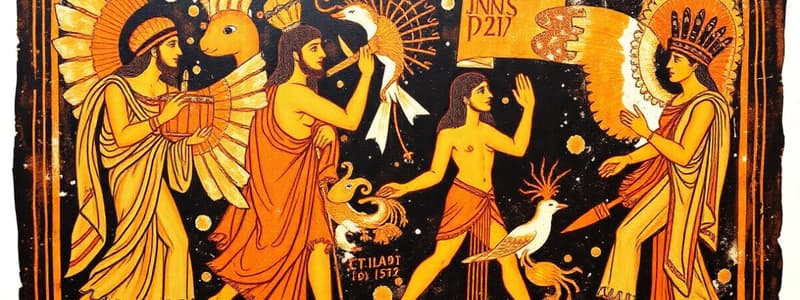Podcast
Questions and Answers
The First Greek Period in painting was heavily influenced by Egyptian styles.
The First Greek Period in painting was heavily influenced by Egyptian styles.
True (A)
The Golden Age of Greek painting focused on representing animals rather than human characters.
The Golden Age of Greek painting focused on representing animals rather than human characters.
False (B)
Etruscan paintings primarily dealt with themes of ancestor worship and burial practices.
Etruscan paintings primarily dealt with themes of ancestor worship and burial practices.
True (A)
In the Medieval Period, Byzantine art focused on depictions of everyday life and landscapes.
In the Medieval Period, Byzantine art focused on depictions of everyday life and landscapes.
Gothic paintings were characterized by grotesque themes and a calmer, more plastic style.
Gothic paintings were characterized by grotesque themes and a calmer, more plastic style.
Flashcards are hidden until you start studying
Study Notes
Prehistoric Painting
- Pre-historic painting existed from 40,000 BC to 9000 BC.
- Subjects focused on hunting, and employed stylistic treatment.
- Pre-historic Greek painting is divided into four periods.
Pre-Greek Period
- This period largely focused on sea and nature motifs.
First Greek Period
- This period had significant Egyptian influence.
Golden Age (480-400 BC)
- Focused on the representation of human character, which expressed a divine system.
- Examples of this period include “The Discus Thrower” (Discobolus).
Hellenistic Period (4th century - 1st BC)
- This period placed emphasis on individualism, featuring tragic moods and contorted faces.
Etruscan Period (2000-1000 BC)
- Paintings were focused on ancestor worship, catacombs, and sarcophages.
Roman Period (2000 BC - 400 AD)
- Paintings were characterized by commemorative statues, sarcophages, frescoes, and designs with vine motifs.
Medieval Period
- The paintings of the medieval period are split into three classifications.
Early Christian Art
- The subject matter in this period includes important symbols like the cross, fish, lamb, dove, and grapes.
- Spiritual expression held more importance than physical beauty.
- A common motif features Jesus as a shepherd caring for his flock, symbolizing protection and guidance.
- Examples are often found in catacombs and early churches.
Byzantine Art
- Subject matter includes Christ as the Creator and Mary as the mother of God.
Gothic Art
- Gothic paintings are religious, grotesque, calmer, and plastic in style.
Studying That Suits You
Use AI to generate personalized quizzes and flashcards to suit your learning preferences.




